The Oratory and the relics of Saint Faustino
San Costanzo
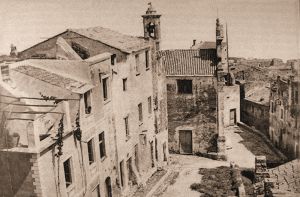 Situated in the square with the same name in the Pigna district, this oratory represents one of the oldest sacred buildings in the city, built on the ruins of a church that fell into ruin in the 16th century: it was the church of Saints Peter and Paul located under the walls of the ancient Castle and mentioned in a document dated 1297.
Situated in the square with the same name in the Pigna district, this oratory represents one of the oldest sacred buildings in the city, built on the ruins of a church that fell into ruin in the 16th century: it was the church of Saints Peter and Paul located under the walls of the ancient Castle and mentioned in a document dated 1297.
It was the custom of the citizens of Sanremo to gather in the churches in difficult cases to deliberate. In the oldest one, dedicated to Saints Peter and Paul, the first Laws were stipulated, drafted and sworn, perhaps summarised later in the Statutes.
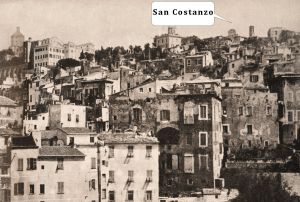 The new church was built in typical baroque style during the 17th century with the façade facing west and after the arrival of the relics of St. Costanzo, consisting of an arm enclosed in a silver case and a jaw inserted in a silver bust of the saint (actually "holy body" of a deceased Christian catacombs, perhaps not even a martyr, to whom devotion is due for being one of the first believers in Christ), the church assumed the title of the Theban martyr, to whom the people of Sanremo always nurtured a particular devotion for the power attributed to him to preserve from violent fevers.
The new church was built in typical baroque style during the 17th century with the façade facing west and after the arrival of the relics of St. Costanzo, consisting of an arm enclosed in a silver case and a jaw inserted in a silver bust of the saint (actually "holy body" of a deceased Christian catacombs, perhaps not even a martyr, to whom devotion is due for being one of the first believers in Christ), the church assumed the title of the Theban martyr, to whom the people of Sanremo always nurtured a particular devotion for the power attributed to him to preserve from violent fevers.
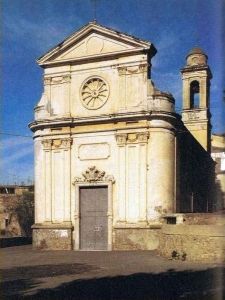 In 1655 the priors of the oratory asked the Council of the Community for permission to carry out some enlargements of the building, which took on the typical physiognomy of a baroque church with a classic sail-shaped façade with curvilinear fastige, refined volutes and abundant stucco decorations. There are not many documents on the subject but thanks to images and descriptions, the outcome of this typically baroque arrangement is known.
In 1655 the priors of the oratory asked the Council of the Community for permission to carry out some enlargements of the building, which took on the typical physiognomy of a baroque church with a classic sail-shaped façade with curvilinear fastige, refined volutes and abundant stucco decorations. There are not many documents on the subject but thanks to images and descriptions, the outcome of this typically baroque arrangement is known.
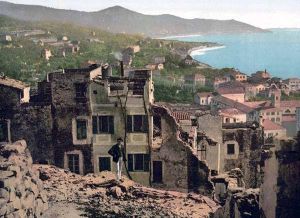
In 1694 the confraternity of the oratory commissioned Daniele Solaro (1634-1699), an altar for the sacred building, which the association wanted to supply with statues and characterised by an accentuated baroque dynamism. But the artist, who had been chosen precisely because of his particularly avant-garde preparation, did not honour the commitments he had undertaken, inducing the commissioners to turn to another sculptor, Ambrogio Franzone (XVIIII century news), who completed the work begun by Solaro, without however fully satisfying the confraternity.
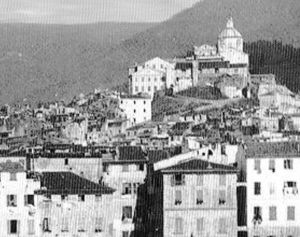
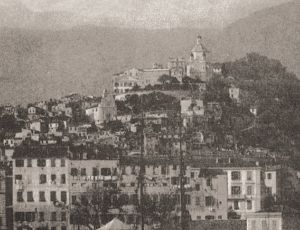 After the disastrous earthquake of 23 February 1887, which demolished most of the houses in the upper part of the Pigna, the oratory was demolished in 1888 and rebuilt in 1897, changing its orientation, which took on an eastern orientation, as was perhaps that of the previous church and as we can see it today.
After the disastrous earthquake of 23 February 1887, which demolished most of the houses in the upper part of the Pigna, the oratory was demolished in 1888 and rebuilt in 1897, changing its orientation, which took on an eastern orientation, as was perhaps that of the previous church and as we can see it today.
The building still incorporates an ancient watchtower for the sighting of Barbarian ships, which can still be seen today in the group of houses that once stood where the palace of the Genoese Archbishops, not far from the residence of the Podesta Luca Spinola.
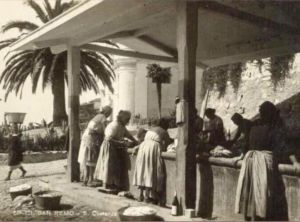
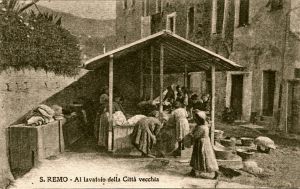 Outside the Church, almost hidden by the houses before the earthquake, there was a public washhouse where the inhabitants of the village came to wash their clothes. After the earthquake, the washhouse was placed more to the side, under the gardens, with the
Outside the Church, almost hidden by the houses before the earthquake, there was a public washhouse where the inhabitants of the village came to wash their clothes. After the earthquake, the washhouse was placed more to the side, under the gardens, with the  cloths stretched out to dry along the supporting edge.
cloths stretched out to dry along the supporting edge.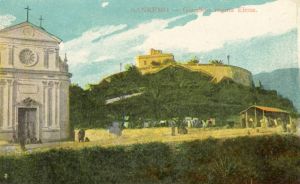
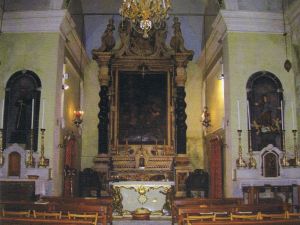 Inside there is a polychrome marble altar of the end of the 17th century, recovered from the old church, located in the presbyterial area and surmounted by two slender columns that enclose the canvas with the Martyrdom of St. Costanzo by Domenico Piola (1627-1703), as well as an artistic organ with a wooden castle and gilded parts in pure gold and two 18th century paintings of Italian style, depicting respectively an Angel with trumpet and blue cloth and an Angel with trumpet and orange cloth, placed on the organ stage in the building's counter-façade.
Inside there is a polychrome marble altar of the end of the 17th century, recovered from the old church, located in the presbyterial area and surmounted by two slender columns that enclose the canvas with the Martyrdom of St. Costanzo by Domenico Piola (1627-1703), as well as an artistic organ with a wooden castle and gilded parts in pure gold and two 18th century paintings of Italian style, depicting respectively an Angel with trumpet and blue cloth and an Angel with trumpet and orange cloth, placed on the organ stage in the building's counter-façade.
In 2008 the Altarpiece dedicated to the martyrdom of San Costanzo by Domenico Piola was restored.
Also in 2008 the organ, dated 1721, by Francesco Giordano from Sanremo, was restored.
In 2011, in addition to the remake of the facade, the restoration of the electrical system and the interiors was completed.
Since then, cultural and musical events have taken place with the intention of raising funds for the work already done and, as the parish priest Don Pietro Rossi hopes, in the future, to "consolidate the work with the restoration of the great Crucifix and the two statues of the Virgin of the Angels and St. Leonard, currently kept elsewhere".
San Faustino
In the past centuries it happened very easily that on the occasion of particular services rendered by priests or laity in favour of the Holy See, the Pontiff himself would donate a portion or the entire body of a Martyr buried in one of the numerous Roman catacombs. This was the case for the mortal remains of St. Faustino kept, since the middle of the XVIII century, in the Oratory of St. Costanzo.
 In 1743, as we learn from documents preserved in the parish archives of S. Giuseppe, Frà Leonardo da Porto Maurizio obtained from Pope Benedetto XIV Prospero Lambertini, the body and an ampulla containing the blood of the Holy Martyr.
In 1743, as we learn from documents preserved in the parish archives of S. Giuseppe, Frà Leonardo da Porto Maurizio obtained from Pope Benedetto XIV Prospero Lambertini, the body and an ampulla containing the blood of the Holy Martyr.
The glass vase also contained a perfectly preserved rose. Pope Lambertini probably wanted to reward Fra Leonardo da Porto Maurizio for his intense work of preaching and spreading the pious exercise of the "Via Crucis" with the gift of an illustrious relic taken from the Catacomb of Santa Priscilla.
It is not clear why the Friar of Porto Maurizio sent the relics of St. Faustino to Sanremo in the Oratory of St. Costanzo. However, since those years the beautiful little church has housed the sacred remains and the City of Flowers, having learned that St. Faustino was a floriculturist, before he entered the ranks of the Roman Legions and was martyred for his faith in Christ, he wanted to recognize him as the protector of floriculture.
(texts elaborated by various Authors; image sources: pesonali and the Group)




